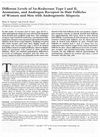New Topical Antiandrogenic Formulations Can Stimulate Hair Growth in Human Bald Scalp Grafted Onto Mice
January 2000
in “
International Journal of Pharmaceutics
”
TLDR Topical treatments can regrow hair on bald scalps.
The study tested topical formulations of finasteride and flutamide on human bald scalp grafts transplanted onto SCID mice to evaluate their effectiveness in treating male-pattern baldness. Both formulations significantly increased the number of hairs per graft, as well as hair length and diameter, compared to a placebo. Flutamide was found to be more effective than finasteride, with 1.22±0.47 hairs/0.5 mm² graft and hair lengths of 5.82±0.50 mm, compared to finasteride's 0.88±0.95 hairs/0.5 mm² graft and 4.50±0.32 mm hair lengths. The study suggested that these topical formulations could effectively reverse male-pattern baldness by re-enlarging hair follicles.










